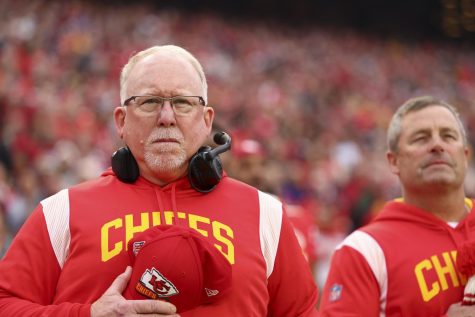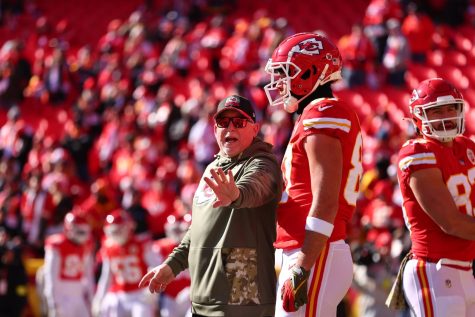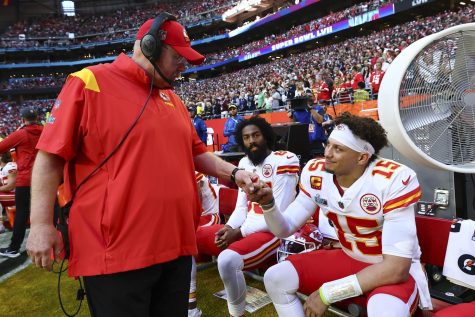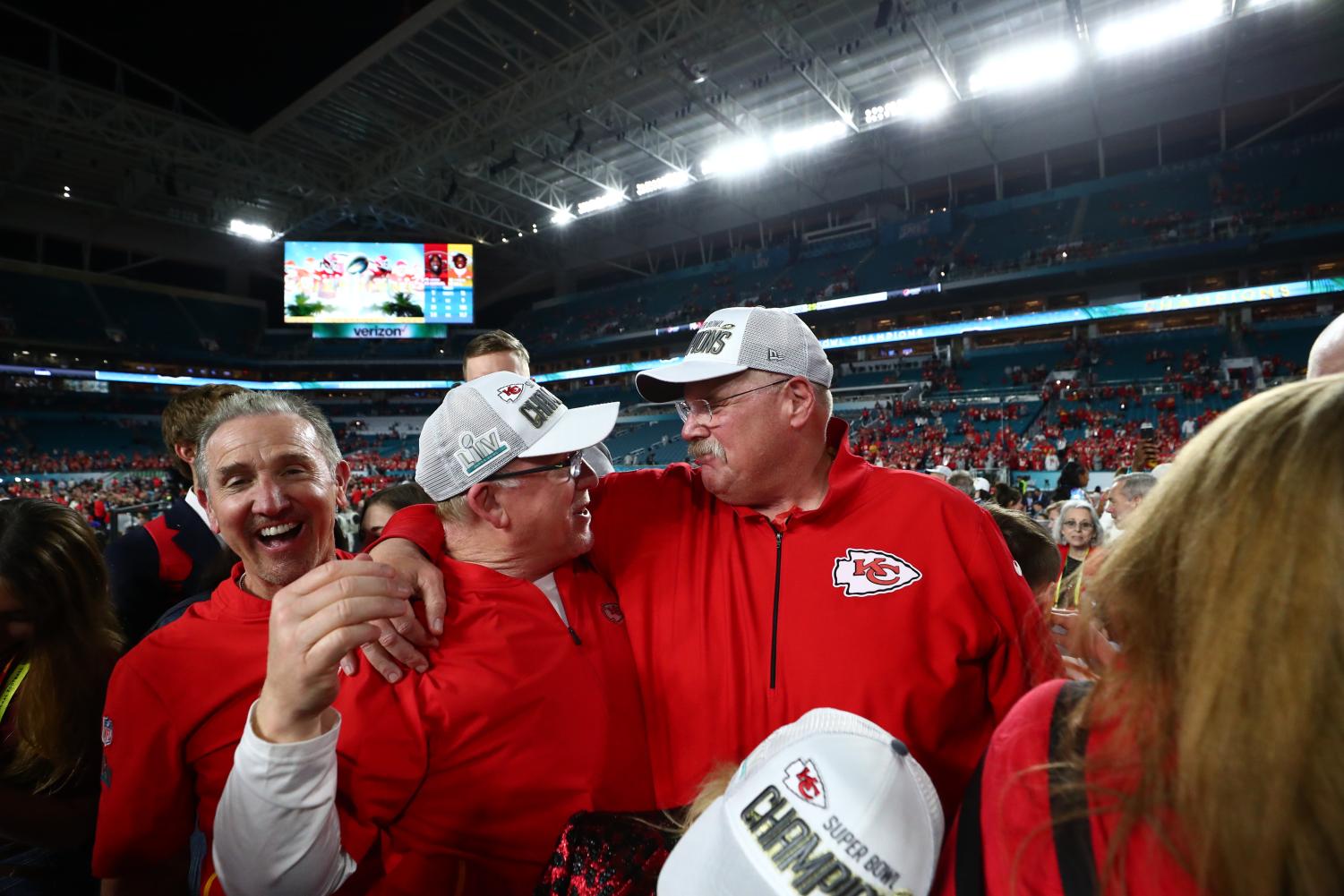
From SF State to Super Bowl champions: the journey of coaching duo Andy Reid and Tom Melvin
Reid and Melvin met each other at SF State in 1983. 37 years later, they’ve won two Super Bowls together with the Kansas City Chiefs.
May 22, 2023
The football program sold hotdogs around campus for $1 apiece to help fund gas for road trips on the bus with a hole in the floor.
They didn’t complain about the lack of funding or the situation they were in. They embraced it. This was the reality of the SF State football program back in 1983, when Andy Reid and Tom Melvin were a coach and player on the team.
Things have changed a lot since then for Reid, 65, Melvin, 61, and the football program, which was shut down in 1994. Now, Reid is the head coach of the Kansas City Chiefs and Melvin is the Chiefs’ tight ends coach. This past season, following a 24-year coaching partnership in the NFL that began at SF State, they celebrated their second Super Bowl victory together.
After graduating from Brigham Young University, Reid became the offensive coordinator for the Gators from 1983 to 1985. Reid and Melvin first crossed paths in the summer of 1983 during training camp.

“It was a great learning experience for a young coach to come in and be able to learn how to coach,” Reid said. “I had a great mentor with Vic Rowen, who helped show me the way. It set up a foundation for me so I could continue on and move up the ladder. And I’ve maintained that foundation. It was simply being able to teach, which is a big part of coaching.”
After making the team, Melvin played football at SF State from 1982 to 1985, becoming Reid’s first graduate assistant. Reid knew of Melvin’s interest in coaching and needed extra help with just three coaches on the staff. So he created a graduate assistant position, which did not exist in the program until then.
Reid was drawn to Melvin because he was a “grinder” who worked harder than everyone else even if he wasn’t as athletically gifted as some of the other players on the team.
“He made sure that coaching wasn’t just a matter of using athletes and then moving on, he’s truly interested in who you are as a man,” Melvin said. “He’s given me great examples of how to proceed in life both on and off the field, as a family man and as a coach.”
They stayed in touch after leaving SF State. Melvin spent a week with Reid every spring so he could learn coaching philosophies and techniques from him that developed since their time as Gators. Melvin would become a part of Reid’s family. They’d go to the office to talk football all day. When Reid became the head coach of the Philadelphia Eagles in 1999, he brought in Melvin as an offensive assistant and quality-control coach. In 2002, Melvin was promoted to tight ends coach, a title he has kept ever since.
Reid and Melvin then went to the Chiefs together in 2013. They’ve currently racked up a 247–138 record. Reid has the fifth most wins by a head coach in NFL history and is just four wins away from taking fourth. Reid has 38 playoff games as a head coach, 22 of which are wins. Both are the second most in NFL history behind the legendary New England Patriots coach Bill Belichick.

“I only knew how Andy did things, and that kind of molded me and how I approached my coaching career,” Melvin said. “He’s got a connection to everybody. So I was fortunate to be the first one in that tree in having a close connection to him. And clearly, it’s worked out for me going forward.”
Reid and Melvin formed a bond through teaching and a passion for food. During recruiting trips to Southern California, they mapped out the best route to a Californian delicacy for double-doubles: In-N-Out Burger. While in Arizona for their last game – their victory in Super Bowl LVII – Melvin brought double-doubles to members of the team who hadn’t gotten to experience it yet. There’s no In-N-Out in Missouri, but Melvin still makes a trip whenever he gets the chance.
This is also how Reid formed a bond with former 49ers head coach Steve Mariucci when they were on the Green Bay Packers staff together from 1992-1995. If they weren’t in their office studying the new West Coast offense, they’d often go out to eat together.
One time, as Mariucci recalled, he and Reid went to the Prime Quarter Steakhouse in Wisconsin. They were informed if they ate their meal in under an hour, they’d get their next meal free and a picture on the wall.
“People hated to see us walk in there, because, hometown buffet for $9.99, all you can eat, can you believe that? They didn’t make any money on us,” Mariucci said.
The meal was enormous — a 40-ounce steak, baked potato, salad and garlic bread. Reid scarfed his down in about 19 minutes; Mariucci in roughly 30.
“We were well under the one-hour clock,” Mariucci said. “They put a bib on ya and a baker’s hat, you take a photo, because you just wolfed down a 40-ounce steak.”

Mariucci said he is proud of Reid for all he has accomplished since their shared growth as NFL coaches in 1992.
“He’s got a great perspective on life,” Mariucci said. “He’s level-headed and his players appreciate it. He’s honest and fair, he knows when to push and when to pull back. He knows what talent is. He always supplies his team with good, young, fast talent. He does it the right way, I’m really proud of him.”
There have been many successful coaches under the Andy Reid coaching tree. John Harbaugh spent nine years as a coach on Reid’s staff in Philadelphia. He’s been the head coach of the Baltimore Ravens since 2009 and led his team to a Super Bowl victory over the 49ers in 2012.
Sean McDermott, who was on Reid’s Philadelphia staff for 12 years, has coached his team to five playoff appearances in six seasons as head coach of the Buffalo Bills.
Doug Pederson spent 7 seasons under Reid between the Eagles and Chiefs. He went on to become the head coach of the Eagles in 2016 and won a Super Bowl with them the following season. He coached the Jacksonville Jaguars to an unexpected playoff appearance last season. These are just a few of the many coaches in the Reid coaching tree to have succeeded in the NFL.
“His staffs have been noted for being great teachers and great human beings,” Melvin said. “And that’s one thing he looks for before he asks them to be on his staff or takes people under his wings. He’s going to be sure that they fit what he thinks is somebody he wants to build up and help pursue in their careers.”
Melvin grew up in Palo Alto before attending SF State and receiving his bachelor’s in arts. Being a Bay Area local, he was a 49ers fan growing up, so beating them for his first Super Bowl title was storybook, as was their second victory against the Philadelphia Eagles.
“That was my team. It was a little surreal,” Melvin said. “My ex-teammates, I had to hold their feet to the fire a little bit. ‘Who you guys gonna root for? Your team you’ve been rooting for all your life or are you gonna go for me and Andy?’ That was a little difficult and actually this last one was too because I spent 14 years in Philadelphia with the Eagles; my kids grew up there and still live there. They’re huge Eagles fans, so they were torn.”

Melvin has coached tight end Travis Kelce since he was drafted by the Chiefs in 2013. Since then, Kelce has racked up the fourth most yards by a tight end all time and has made eight straight pro bowls. Kelce’s career has shown the coaching capabilities of Melvin in his own right.
Since the 2018-19 season, the Chiefs have made 5 straight AFC Championship games and have two Super Bowls in three trips to show for it. Mariucci believes the Chiefs will be a competitive team for years to come, with a young Patrick Mahomes leading the way at quarterback and many other weapons decorating the roster. He doesn’t believe Reid plans to retire anytime soon.
“God willing, Patrick stays healthy and Andy stays healthy, they’re always going to be a good team,” Mariucci said. “So there’s more out there in front of them. I always ask him how much more you’re going to coach and he just laughs because he doesn’t think about retiring, he’s having so much fun.”
In retrospect, Reid valued the opportunities afforded to players like Melvin, which may not have been available at larger schools with more highly regarded athletes.
“It was a non-scholarship program. So I thought it was great for kids that want to play college football, but weren’t quite good enough to get a Division I or a NCAA scholarship at that time,” Reid said. “So it gave them an opportunity to play, and I’ve stayed in touch with the players. And that was a great experience for them, something that they’ll treasure for the rest of their lives.”


